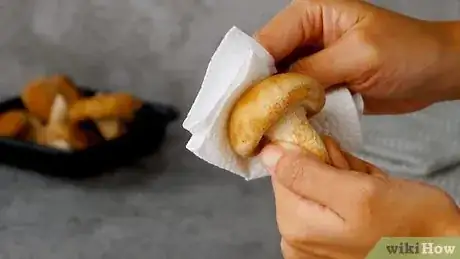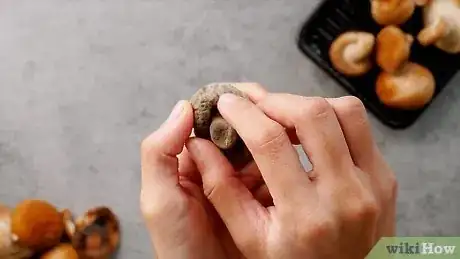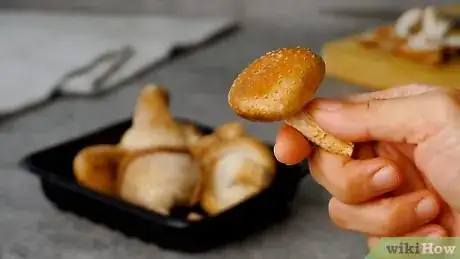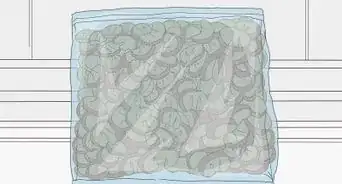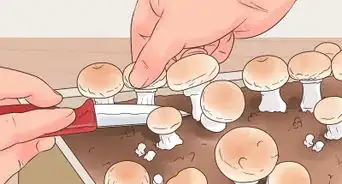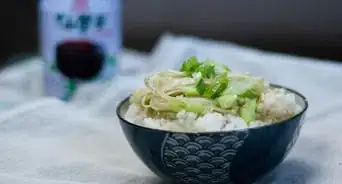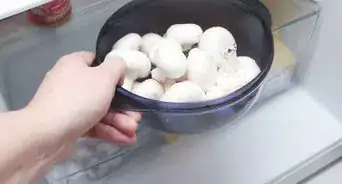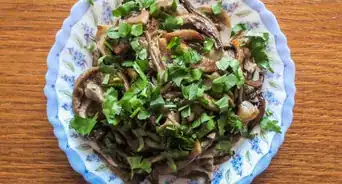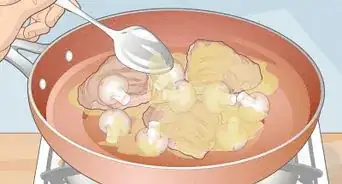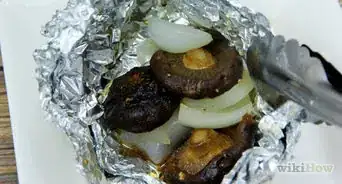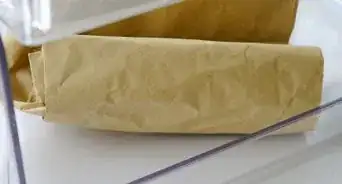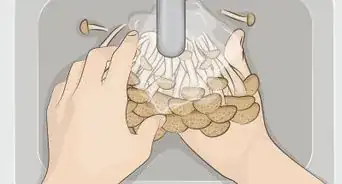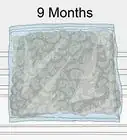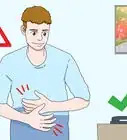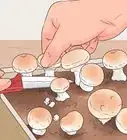This article was co-authored by Ollie George Cigliano. Ollie George Cigliano is a Private Chef, Food Educator, and Owner of Ollie George Cooks, based in Long Beach, California. With over 20 years of experience, she specializes in utilizing fresh, fun ingredients and mixing traditional and innovative cooking techniques. Ollie George holds a BA in Comparative Literature from The University of California, Berkeley, and a Nutrition and Healthy Living Certificate from eCornell University.
This article has been viewed 47,417 times.
Opt for locally-grown, organic shiitake mushrooms whenever possible. Less transportation and chemical-free farming means you won’t need to worry about cleaning them too much. That said, it’s always worth wiping mushrooms clean and giving them a quick rinse. Shiitake mushrooms should also have their stems removed before cooking.
Steps
Washing Shiitake Mushrooms
-
1Wipe away visible dirt. If the mushrooms are still caked with dirt or other debris, gently remove it by hand. Use a clean cloth, dry paper towel, or soft-bristled brush if you prefer. Don’t worry too much about getting every bit of dirt.[1]
- There are kitchen brushes designed to help clean delicate foods, such as shiitake mushrooms. While these can be helpful, they are not necessary.
- Often, a quick rub with a dry paper towel is sufficient.
-
2Rinse minimally. It’s true that mushrooms will absorb a bit of moisture, so you don’t want to expose them to too much water. However, a quick rinse will not noticeably affect their composition. Simply run the faucet with cold water and hold your shiitakes in the stream for a few moments.[2]
- Some chefs prefer not to rinse shiitakes. If you know your mushrooms are free of chemicals, consider foregoing the use of any water at all.
Advertisement -
3Shake or spin them dry. Shake the mushrooms by hand or spin them in a salad spinner to remove residual water. If water remains caught on the underside of a particular mushroom, hold it by the stem and shake more vigorously.[3]
- Rinse again if visible dirt remains.
- It's important to make sure the mushrooms are completely dry before cooking them.
Removing the Stem and Slicing
-
1Pry off each mushroom’s stem. While keeping the stem is a matter of personal preference when preparing many mushrooms, shiitake stems should always be removed. To remove a shiitake stem, tightly pinch it right where it meets the cap. Then slowly pry the stem away from the cap in the opposite direction the stem is leaning.[4]
- For instance, if you’re holding the mushroom upside down and the stem is leaning towards you, pry the stem away from you.
- Discard the stems or save them for use in soups and stocks.
-
2Remove dried mushroom's stems before re-hydrating. Dried shiitake mushrooms aren't quite as flavorful, but they can be good to keep on hand because they last a long time and are especially useful in some dishes. They do require a bit more prep work, however, as they need to be soaked in water prior to cooking. Just be sure to snap off the stems first, as it's much easier to do while they're still dry.[5]
-
3Slice from the top of the cap. Depending on how you wish to use your shiitake mushrooms, you may wish to cut them up. Thin slices are recommended. Place a cap right side up on a cutting board and carefully cut it into thin slices.[6]
- If you’re comfortable doing so, you can stack one shiitake mushroom cap on top of another and slice them simultaneously in order to save time.
Selecting and Storing Shiitake Mushrooms
-
1Select shiitakes from loose bins. Whenever possible, opt for mushrooms sold out of loosely packed bins, as opposed to plastic-wrapped containers. This will allow you to select the cleanest and best-looking individual mushrooms.[7]
- Look for the mushrooms with the thickest caps.
-
2Choose firm, dry shiitakes. Both the stem and the cap of the mushrooms you select should be firm and dry to the touch. Mushrooms with domed caps that curl under are especially fresh. Avoid shiitakes that appear shriveled, or feel soft or slimy to the touch.[8]
- The gills on the underside of the mushroom’s cap should be dry and firm too.
- Dark spots or a wet appearance indicate that a mushroom is past its prime. This evidence will first show itself on a mushroom’s gills.
-
3Store mushrooms in the fridge. Refrigeration can help keep your mushrooms fresh. Keep them in an open plastic bag, as they need access to air. If you purchase them fresh, they will last for a few days.[9]
- If you want to preserve shiitakes in the fridge for a bit longer, cut off their gills. This will keep the rest of the mushroom fresh for about a week.
Community Q&A
-
QuestionAre shiitake mushrooms the same as the brown mushrooms that can be bought from the supermarket?
 Community AnswerYou're likely thinking of button mushrooms, which are not the same as shiitake mushrooms. But depending on your supermarket, you may be able to find shiitake mushrooms there.
Community AnswerYou're likely thinking of button mushrooms, which are not the same as shiitake mushrooms. But depending on your supermarket, you may be able to find shiitake mushrooms there.
References
- ↑ http://www.seriouseats.com/2014/10/knife-skills-how-to-clean-shiitake-portobello-oyster-mushrooms.html
- ↑ http://allrecipes.com/video/11/how-to-clean-mushrooms/
- ↑ http://allrecipes.com/video/11/how-to-clean-mushrooms/
- ↑ http://www.noreciperequired.com/technique/how-clean-shitake-mushrooms
- ↑ http://www.vietworldkitchen.com/blog/2013/01/shiitake-mushroom-tips-how-to-buy-soak-prep.html
- ↑ http://www.seriouseats.com/2014/10/knife-skills-how-to-clean-shiitake-portobello-oyster-mushrooms.html
- ↑ http://www.seriouseats.com/2014/10/knife-skills-how-to-clean-shiitake-portobello-oyster-mushrooms.html
- ↑ http://www.seriouseats.com/2014/10/knife-skills-how-to-clean-shiitake-portobello-oyster-mushrooms.html
- ↑ http://www.seriouseats.com/2014/10/knife-skills-how-to-clean-shiitake-portobello-oyster-mushrooms.html
About This Article
To clean shiitake mushrooms, start by wiping away any visible dirt with a clean cloth or paper towel. Next, do a quick rinse with cold water and shake the mushrooms by hand or spin them dry in a salad spinner. To remove the stem, pinch it tightly where it meets the cap and slowly pry the stem away in the opposite direction that the stem is leaning. If you want to cut the mushrooms, place the caps right side up on a cutting board and carefully cut into thin slices. For more tips, including how to pick the best mushrooms, read on!
